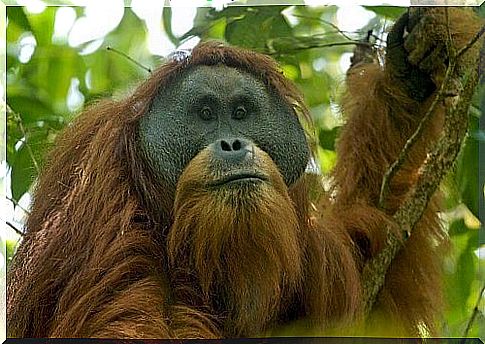A New Species Of Orangutan: Let’s Discover It Together

It seems incredible, but even today man continues to discover new animal species. This time the discovery concerns a living being very close to the human species: the orangutan. Together with the chimpanzee and the gorilla, this primate shares over 99% of the genetic code of Homo Sapiens Sapiens .
The news is even more interesting when you consider the fact that, in general, most of the recent findings involve, for the most part, insects or other small animals.
This has not been the case for the so-called great apes for almost a century . In particular, it was in 1929 when a subspecies of bonobo was discovered. Thanks to this new piece that science has added to natural history, the number of great apes now rises to 7.
Tapanuli, a new species of orangutan
This new orangutan species has been spotted on the island of Sumatra, Indonesia, and has been named Tapanuli ( Pongo tapanuliensis ). Although its population is estimated at around 800 individuals, it is in danger of extinction. Previously, the orangutan genus consisted of only two species : the Sumatran and the Bornean orangutan , which includes several other subspecies.
This orangutan population was discovered a long time ago by Australian scientists, but the differences with the more well-known specimens are difficult to prove. The differences between the Pongos and their Tapanuliensis cousins began to emerge by measuring the skulls of some dead specimens.
Only thanks to a genetic analysis, carried out on 37 wild orangutans, it was possible to definitively prove that the Tapanuli developed out of the orangutan breed as early as 10 thousand years ago.
It should be remembered that the main threat from orangutans is deforestation. In Indonesia, since the 1950s, a territory equivalent to that of the United Kingdom and Spain united together has been lost.
The main reason for this deforestation are oil palm plantations, which are tempting the food industry due to the use of this product in many foods, such as snacks, spreads and so on.
Deforestation in the name of palm oil
Palm oil is a vegetable oil that appears in hundreds of products, such as cocoa creams, industrial pastries, chocolates, processed foods, etc. Most palm oil production is estimated to be causing the deforestation of areas with significant biodiversity. It is estimated that, all over the world, production affects work on land so vast that it occupies 90 football fields every hour.
To plant the palm, the forest must be burned and it is becoming scarcer. In 2015 alone, nearly two million hectares were burned to meet palm consumption in the food market.
This not only affects orangutans, but also other species, such as the Asian elephant or the Sumatran tiger, which are closely related to these tropical forests.
Is it too late to save Tapanuli?
Orangutans are one of the most intelligent species in the animal kingdom. Like chimpanzees, they are able to learn and use sign language to communicate. They are able to understand concepts such as death or to use and create new tools.
The most famous case was that of Chantek, an orangutan from the Atlanta Zoo who was able to understand spoken English and communicate fluently through sign language.
This new species of orangutan increases the enormous richness and biodiversity of nature in Southeast Asia, but also indicates what the consequences may be deriving from the economic interests of the human being.
Is it too late to save the Tapanuli? Unfortunately, scientists warn that this species is particularly vulnerable, and therefore measures to preserve the habitat of orangutans should be stepped up.
The problem is that humans often discover new species after their extinction, thanks to fossils and remains. In the case of the Tapanuli, this happened at a time when it is still possible to remedy our mistakes and save him.









